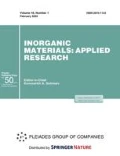Abstract
Carbonated hydroxyapatite (CHA) owing to its chemical and phase composition that is similar to that of the inorganic component of native bone tissue is a promising material for reconstructive surgery to heal bone defects that are caused by trauma and extensive surgery. An original method for obtaining porous CHA ceramic granules was developed. To obtain a system of interconnected pores, a protein foam with sucrose was used. The optimum ratio of the protein foam to the ceramic CHA powder was found to be 3: 1 for production of porous ceramics with a homogeneous structure. The mechanical properties of the porous CHA ceramics that we obtained at different ratios between the protein foam and ceramic CHA powder were studied: as the concentration of the ceramic CHA powder increased in the mixture, the compressive strength of the CHA ceramics decreased from 6–7 to 2–3 MPa. The microstructure of the CHA ceramics is characterized by the presence of pores that are different in size, from fractions to tens of microns. In vitro studies of the porous CHA ceramics were performed. The evaluation of the influence of the granules on the growth of rat MMSCs in vitro revealed a decrease in the cell viability with an increase in the concentration of the granules. The reduced viability of the MMSCs in the presence of the granules can be associated with alkalization of the environment by the sintering additive.
Similar content being viewed by others

References
Tikhilov, R.M., Shubnyakov, I.I., Kovalenko, A.N., Chernyi, A.Zh., Murav’eva, Yu.V., and Goncharov, M.Yu., Register data of hip replacement in the Vreden Russian Scientific Research Institute of Traumatology and Orthopedics in 2007–2012, Travmatol. Ortop. Ross., 2013, vol. 69, no. 3, pp. 167–190.
Fadeeva, I.V., Meditsinskaya keramika iz zameshchennykh fosfatov kal’tsiya (Medical Ceramics from Substituted Calcium Phosphates), Moscow: Universitetskaya Kniga, 2016.
Barinov, S.M., Bibikov, V.Yu., Ďurišin, J., Fadeeva, I.V., Ferro, D., Komlev, V.S., Medvecký, L., Cesaro, S.N., and Rau, J.V., Sintering of porous carbonated apatite bioceramics, J. Powder Metall. Progr., 2004, vol. 4, no. 2, pp. 96–102.
Villarreal, D.R., Sogal, A., and Ong, J.L., Protein adsorption and osteoblast responses to different calcium phosphate surfaces, J. Oral Implantol., 1998, vol. 24, no. 2, pp. 67–73.
Li, B., Chen, X., Guo, B., et al., Fabrication and cellular biocompatibility of porous carbonated biphasic calcium phosphate ceramics with a nanostructure, Acta Biomater., 2009, vol. 5, pp. 134–143.
Barinov, S.M., Smirnov, V.V., Fadeeva, I.V., Komlev, V.S., and Bibikov, V.Yu., RF Patent 2280017, 2006.
Praktikum po tekhnologii keramiki (Practical Manual on Ceramic Technique), Guzman I.Ya., Ed., Moscow: Stroimaterialy, 2005.
Author information
Authors and Affiliations
Corresponding author
Additional information
Original Russian Text © I.V. Fadeeva, A.S. Fomin, Ya.Yu. Filippov, S.A. Bozhkova, D.V. Labutin, S.M. Barinov, 2018, published in Perspektivnye Materialy, 2018, No. 4, pp. 24–30.
Rights and permissions
About this article
Cite this article
Fadeeva, I.V., Fomin, A.S., Filippov, Y.Y. et al. Porous Carbonated Hydroxyapatite Ceramics Obtained by the Original Method of “Ceramic Biscuit” for Medicine. Inorg. Mater. Appl. Res. 9, 879–883 (2018). https://doi.org/10.1134/S207511331805009X
Received:
Published:
Issue Date:
DOI: https://doi.org/10.1134/S207511331805009X



